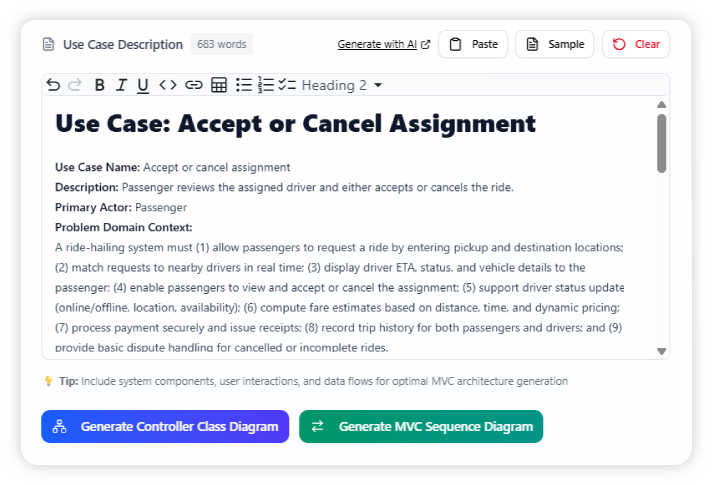Now Reading: From Use Case to Sequence Diagram | Sequence Diagram Refinement Tool
-
01
From Use Case to Sequence Diagram | Sequence Diagram Refinement Tool
From Use Case to Sequence Diagram | Sequence Diagram Refinement Tool
A clear use case description is the foundation of effective system design. Before drawing sequence diagrams, documenting what a system should do in simple language ensures accuracy, consistency, and a smoother transition into visual models.
What Is a Use Case Description?
A use case description is a structured narrative that outlines how an actor interacts with a system to achieve a goal. It includes:
- Actors – the people or systems initiating the interaction
- Preconditions – what must be true before the scenario begins
- Main flow – the step-by-step process of achieving the goal
- Alternative flows – variations or exceptions that may occur
- and more…
This textual foundation acts like a blueprint, ensuring everyone understands the system’s behavior before translating it into diagrams.

Why Start with Use Case Descriptions?
Clarity Before Complexity
Writing in plain text avoids misinterpretation. Everyone — from developers to stakeholders — can agree on the scenario before visual modeling begins.
Consistency Across Models
Not only the sequence diagram, the same description can also be reused to create multiple diagrams, such as activity diagrams, sequence diagrams, or class diagrams, ensuring alignment.
Better AI Refinement Results
The Sequence Diagram Refinement Tool works best when the source diagram is based on a solid description. The clearer the description, the more accurately AI can identify MVC components later.
From Description to Sequence Diagram
Once the description is ready, it becomes straightforward to create the initial sequence diagram. For example, in a Withdraw Cash scenario:
- Actor: Bank Customer
- Steps: Insert card → Enter PIN → Select amount → Dispense cash
This simple outline is enough for a base diagram showing the interactions between the customer and the ATM system.
Making the Process Seamless with VP Online
Pairing the AI Generator with VP Online provides flexibility:
- Start from a text-based description
- Quickly sketch the base diagram
- Edit and customize the results directly in VP Online’s diagram editor
This workflow ensures nothing gets lost between text, diagrams, and architecture — a consistent pipeline from idea to implementation.


